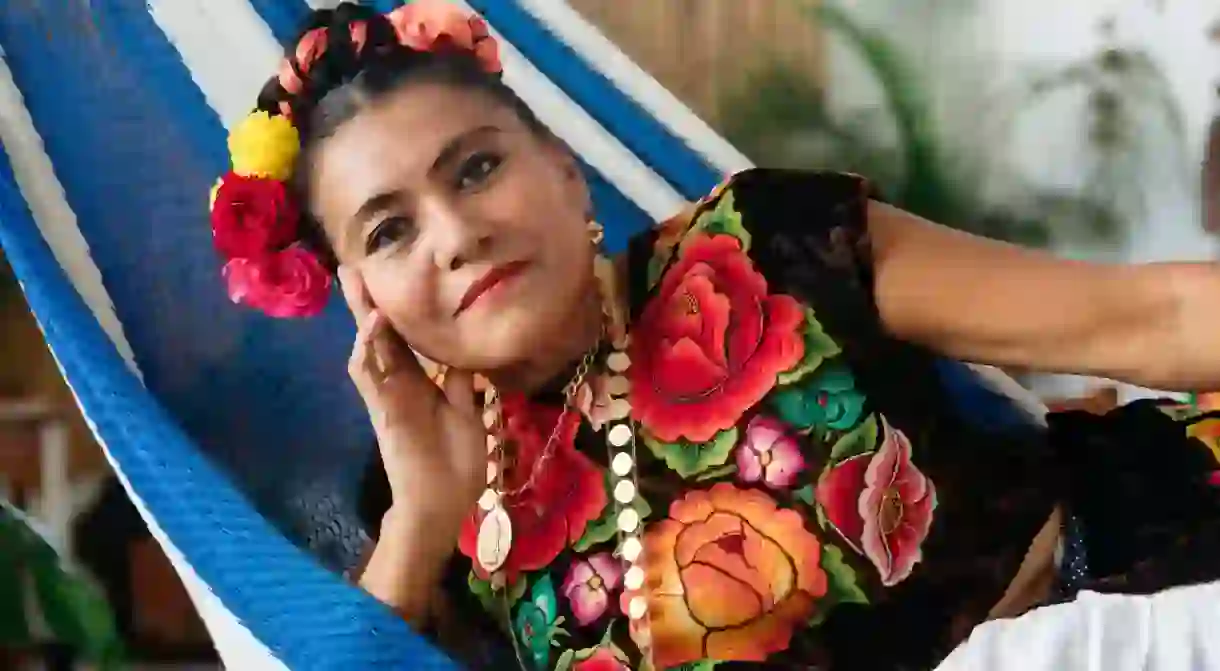Behind the Scenes of Traditional Juchitán Dressmaking

Tehuana is known for its iconic dress style. One designer explains the tradition of dressmaking in her Mexican hometown.

You may recognize the brilliantly colored smocks and layered skirts of the Tehuana women from images of one of Mexico’s greatest icons – Frida Kahlo. Maybe you’ve seen the rounded lace collar of the region in Kahlo’s painting Self-Portrait as a Tehuana. Kahlo’s mother was Oaxacan, which (combined with her deep connection to traditional Mexican arts and crafts) may be the reason why she incorporated the Tehuana style into her wardrobe and painting.

The traditional dressmaking and embroidery of this southern region is famed throughout Mexico. The town of Juchitán, over 270 kilometers south of Oaxaca City, is considered a main commercial center of this state.

From a very young age, the women of Juchitán are instructed by their families in the art of making crafts – embroidery, painting, knitting. They learn to not only make things, but also to sell them.

Nereyda Charis is a traditional dressmaker in the town of Juchitán. According to her, every member of the family is taught a craft and the secrets of selling in these more rural areas.
As a child, long before Charis was embroidering, she walked the streets selling the fresh cheese her grandparents used to make. “I was about eight years old, and no one made me do it; I loved to go out and sell. It’s part of our tradition, regardless if you are rich or poor, a professional or not, everyone is always selling a little something extra on the side.”

You won’t see many men selling wares in the local market. “There is a kind of prejudice towards men selling in the market,” says Charis, “Men must look for other more labor-intensive work. Men traditionally farm, fish or produce things that then the women of their families sell in the local market.”

These days, Charis makes and sells one of the region’s most on-demand items, the labor-intensive and heartbreakingly beautiful Tehuana-style embroidered dresses.

In Juchitán, there are four types of traditional dresses, according to Charis. One is for use inside the house and made of a simple and inexpensive huipil and rabonas. Huipils are short square-cut shirts, sometimes with sleeves and sometimes simply with slits in the side for the arms. The rabonas are long skirts, sometimes embroidered or decorated.

A second type of dress is a version of the first but with slightly higher quality materials and craftsmanship. For casual parties (like a birthday with a live band, for instance) women might wear what is considered media-gala, which includes a huipil that has been expertly made with a chain stitch to display geometric patterns on its edges, and an embroidered skirt made with high-quality material. At these types of events, married women wear a crown of flowers that is oriented towards the right and unmarried women wear it to the left.

For very formal parties, like a quinceañera or one of the region’s famous public parties held from April to September called velas, the women dress in full gala style, with huipils and skirts that are even more detailed with flowers and patterns, as well as a collection of jewelry, both new and antique. They where slips under their skirts and often braid brightly colored ribbons into their hair.
The designs of these embroidered pieces are part of what makes them a showpiece in the local community and beyond.

When asked where Charis gets her design inspiration, she replied: “I don’t think that you need to go to design school. Everything you could possibly need to inspire you is right here in Juchitán. There’s inspiration in everything you see, everything you eat, everything you come across, that’s where the designs are. Lots of famous painters have been inspired by Juchitán, like master painter Toledo – the majority of his great work was inspired by his time right here in Juchitán.”

It’s true that much of the design work is based in natural elements like local flora and fauna – and particularly roses – which are ubiquitous among the Juchitán dresses.
The work that it takes to create one of these splendid pieces is extensive. Some families enlist all the members of the household to work on large projects. But if a seamstress is at it alone, a Juchitán dress will likely take five to six months to finish.

“It’s a personal work,” says Charis, “Some women pay others to help them stitch in order to advance quickly, but most women don’t like that. They like to be in charge of the design and the colors and the type of thread they are going to use.”
“The complexity of your design, the quality of your materials, and your desired timeframe all affect the price,” says Charis. “If you are looking to buy something quickly or something more touristy and cheap, the markets of Juchitán all sell traditional huipils and skirts. If you want the real deal, however, you might have to put in an order and then have patience.”














